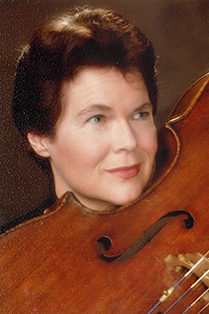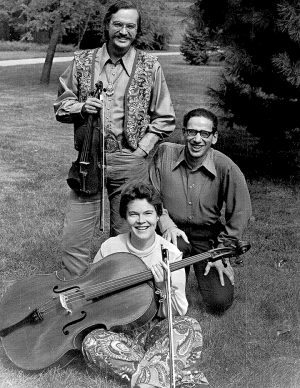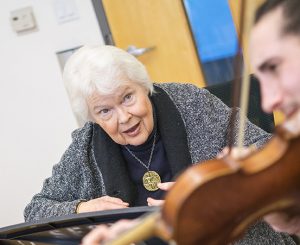 by Alex Walsh
by Alex Walsh
Bonnie Hampton is a cellist, teacher, Berkeley native, and Local 6 life member. In the 1960s she was a founding member of the Francesco Trio, which recorded and toured internationally. She has taught in many educational settings including Stanford, Mills College, Julliard, and the San Francisco Conservatory of Music.
Bonnie Hampton was born in Berkeley, CA, in 1935. Her father was an attorney and her mother was an amateur violinist. Growing up, her house was filled with music. Bonnie’s older brother and sister played, and her parents rented out rooms to Cal music students.
One day, when Bonnie was 4, her mother found her doodling on the family piano, so she decided to give her lessons. When she was 8, Bonnie discovered the cello her mother had borrowed from a friend–she was hooked. “My mother was actively involved with the beginnings of the Young People’s Symphony, so naturally when I was ready to join them, that was my youth orchestra. I’m very proud that it’s still going and doing well.”
Bonnie’s inclination for teaching began at an early age. “I remember walking home when I was 13 and this kid rode by with a cello on her handle bars. She stopped and it turned out she was my age and she lived a block away, so I said, ‘Why don’t we get together and play some duets?’ She only had public school lessons, so I helped her. I arranged for my teacher to hear her and she took her as a student. I helped with her audition material and she got into the Young People’s Symphony. Ellen Dessler is her name. She made her living as a single parent raising four kids as a cellist in the shows in San Francisco.”
Bonnie was so passionate about cello that her parents decided to homeschool her. She began studying with Margaret Rowell, a legendary teacher with an international reputation at the center of the burgeoning Bay Area cello community. “Margaret was the magnet for all the cellists to come visit. Not only was she a wonderful teacher, she would really welcome them. She helped me get started and encouraged me to teach.”
During her teenage years, Bonnie says she was always taking lessons from the musicians and professors at Cal and the SF Conservatory. She became a fixture at Cal when they started their noon-time concert series and played in so many different chamber groups that they finally anointed her Official Un-official Student. Bonnie says she was taking the courses she wanted to take but had no intention of getting a degree. “I was just doing what a young musician does, running around doing everything.”
Hired to play in the Composers Forum at Mills College with the composer Leon Kirshner, Bonnie joined the union when she was 17. The philosophy around her at the time was that you learned to perform by doing it. She played in as many different situations as she could, including the Hungry i night club in San Francisco for a special chamber music series, San Quentin prison with the SF Conservatory chamber group, and three times as a soloist for the San Francisco Symphony. “I enjoyed playing in orchestras, but I was very bitten by the chamber music bug. Of course, I’ve had students win auditions for orchestras and earn three times as much as I would ever earn, but I just knew that’s what I wanted to do.”
During her 20s, Bonnie taught regularly in Berkeley and Marin County, played in contemporary groups including as guest with the Griller Quartet, and many Concerto performances. She also started teaching at Mills College where she was a part of the Mills Chamber Players.

The Francesco Trio in the 1970s: David Abel, violin, Bonnie Hampton, cello, Nathan Schwartz, piano.
By necessity, Bonnie learned how to be her own concert promoter. “I think it’s the musicians who are able to keep their own projects going that are able to keep refreshing themselves. I learned pretty early that everybody will ask me to do their project, but how come no one is asking me to do my project?” When the phone stopped ringing Bonnie took up the slack by producing a series of 3 concerts. “I had to rent the hall, print the programs, hang the posters, and figure out how to get the stuff into the paper on time. Playing the two-hour concert was the easiest part of it. It made me realize that if people see you doing that they’ll think of you for other kinds of work. You can’t assume that our culture is just going to hand it to us.”
In the early 1960s Bonnie spent time in New York. She was invited to play for many projects but knew she would have to live there full-time in order to take full advantage of them. This would also limit her ability to do her own projects. “I saw my peers in New York running around like crazy trying to pay the rent. I was given offers, and it was very attractive, but there were two things – I felt I could make more of a contribution in the Bay Area, and I could create a direction for myself rather having to do what someone asked me to do. There are a lot of opportunities that open up if you are in New York, but I don’t complain about the opportunities here. We became known, especially in the 60s, as being a very cello friendly place.”
THE FRANCESCO TRIO
Bonnie started the Francesco Trio in 1964 with violinist David Abel and pianist Nathan Schwartz. “The first year we played a few concerts, the second year a few more, and then we got invited to do a tour in Alaska and British Columbia. We won the Naumburg Chamber Award which put us on the international map with management and touring, and we procured a part-time residency at Stanford University.”
The trio taught at Stanford for a few years but left for a fulltime residency at Grinnell College in Iowa, which offered a better contract. Stanford was shocked that they would leave for such a small school, but eventually got them back by offering them a fulltime residency with health insurance and retirement benefits.
In 1972, Bonnie joined the faculty of the SF Conservatory where she taught for 30 years.
“In the 60s and 70s, the cello community was very tight-knit.All the cellists who came through the SF Symphony—you name any cellist from that period—Casals, Rostropovich, Starker, Rose, we did things together. When Casals was here I was involved in getting together the 65 cellists to play one of his pieces at the Opera House. We were very active with all these giants.” When Bonnie was invited to play Mahler with the SF Symphony, the conductor Seiji Ozawa urged her to stay, but she declined because of her trio.
In the 1980s, Bonnie started the Masters in Chamber Music at the SF Conservatory, the first of its kind in the nation. In the 90s, Bonnie’s husband Nathan (pianist in the Francesco Trio) was diagnosed with leukemia. They eventually stopped touring but continued to play concerts locally until he passed in 2002. “Once Nathan died, I realized that teaching was going to be more of my life. It had always been a balance of the two things. I loved teaching but I also wanted to play as much as possible. It’s a juggling act.”
For a change of pace, Bonnie accepted a contract to teach at Julliard. She moved to New York and liked it so much she stayed for 9 years. When she decided to return to the West Coast, she would go back to teach at various schools for special projects and mini-residencies. “I’m a homing pidgeon, I just keep coming back to Berkeley.”
Now in her 80s, Bonnie says she can still do everything she’s always done musically, just not so much of it. In 2018, the SF Conservatory bestowed an Honorary Doctorate degree on her and asked her to return and teach chamber music. “When they asked me to come back and do more I thought, ‘If I’m going to accept an honorary doctorate I’d better earn it!‘”

Photo by Victor Xie.
“If there’s anything that I would like to get across to students, it is the wonder of it. I’ve had to tell students, ‘Look, you may need to earn your living another way for a while. But you’ll still learn and grow as a musician.’ I believe in having music in your life. It’s a hard profession. With an opening in the symphony there are 200 applicants. And who’s going to get the job? One person. But I still think it’s worth trying. I just believe in music, what can I say?”
